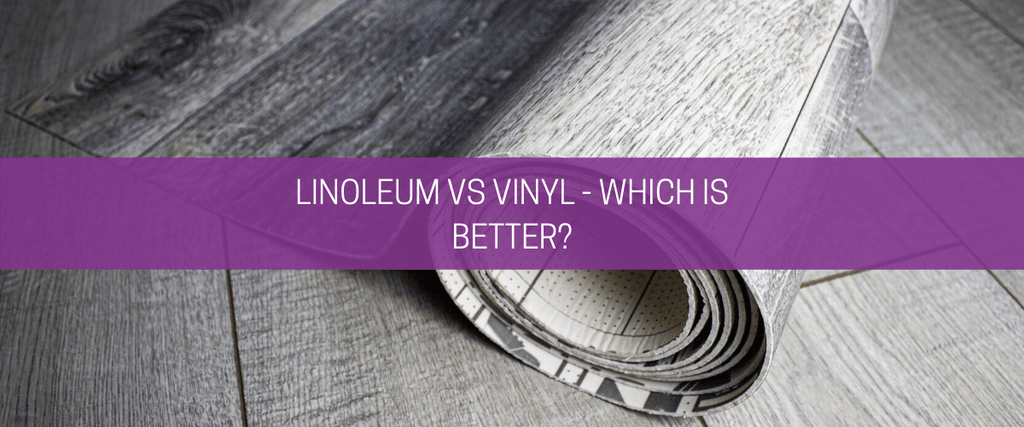Linoleum vs vinyl – which is better?

Linoleum (lino) and vinyl are often confused as the same thing. Yes, they may share many similarities – but they are, in fact, two completely separate products, with different advantages and disadvantages. Therefore, when it comes to choosing the best flooring for your project, it’s important to do your research thoroughly and choose the right one for you.
5 differences between linoleum and vinyl floor tiles
1. Construction
All vinyl flooring – including luxury vinyl tiles (LVT) – has a layered construction. Usually, these are in the form of planks such as wood and laminate flooring. The first is a protective layer (typically finished with urethane), which helps to prevent scratches and stains – almost double the strength and protection vs wood and laminate floorings. The bottom layer is the ‘core’, which gives the flooring its rigidity and durability – but most important, it’s waterproof! So, it can go in kitchens and bathrooms.
Linoleum – also known as lino flooring – is very different. This is flooring in a rolled-up form (see the pictures). It’s very easy to lay, cheaper and looks very modern when installed correctly. This is also waterproof and you’ll see this kind of flooring in almost every new home build in the bathrooms.
Essentially, lino flooring is made from a variety of natural materials, including linseed oil, jute, cork powders, wood flours, tree resins and more. These materials are mixed together and – unlike LVT – the design is embedded throughout (rather than printed on a single layer).
2. Design
Vinyl floor tiles (or LVT) come in a wide range of styles and patterns. For example, you can choose from:
- authentic hardwood and stone designs (which mimic the look and texture of the real thing)
- a variety of popular colours
- single and multi-width planks
- various on-trend finishing effects (such as liming, hand-scraping, whitewashing)
Whatever you have in mind, you’re bound to find the perfect LVT to bring your ‘interior design’ vision to life. By contrast, linoleum isn’t anywhere near as versatile. Due to the way that it’s made, it can only replicate relatively simple patterns and colours and there are significantly fewer styles to choose from.
3. Durability
Linoleum and vinyl are both very long-lasting products. But in terms of durability, vinyl floor tiles definitely have the edge. Not only are they resistant to scratches, stains, and furniture dents, they’re also fully waterproof and can withstand heavy and continuous levels of footfall.
By contrast, linoleum isn’t as resilient. It’s much more susceptible to everyday wear-and-tear and – unless regularly re-sealed around the edges – it can lose its water-resistance over time. This can be within 5 years, whereas LVT vinyl plank tiles can last up to 30 years. Lino flooring is also vulnerable to moisture and humidity.

4. Installation
Linoleum flooring can be easy to install for small areas. In larger areas, it can be harder as it’s typically sold in sheet form – so it is large, stiff and tricky to handle. It also needs to be glued directly onto the subfloor and treated with a sealant topcoat (optional). Therefore, most people find it a challenging task and ultimately seek the help of a professional fitter.
Vinyl LVT Flooring sits at the other end of the scale. It’s regarded as one of the easiest types of flooring to install – particularly if bought as click-and-lock tiles – and most people can do the job quickly by themselves. No glue is required, simply click and fit. You will need specialist LVT underlay for extra protection, but again very easy to lay.
5. Maintenance
Both linoleum and luxury vinyl tiles are fairly easy to maintain. To keep them clean, you can simply sweep and vacuum away the dust and use a damp cloth to wipe away small spillages and stains.
However, it’s important to note, linoleum can be sensitive to some cleaning products. It’s always worth checking the bottle and doing a test (in a discreet area) before you mop the entire room. To maintain its water-resistance, lino will also require an annual coating of sealant.
Which should I buy?

We recommend Royale flooring products, you can see them all on our website for sale here: https://www.carpet-underlay-shop.co.uk/collections/flooring. Royale is a well-known German brand, most commonly used for commercial jobs and new home builds – so you can rest assured you’re getting good quality with Royale flooring products (also within the education and healthcare sector specified).
If you would like further information on the differences between these two types of flooring, you’re always welcome to get in touch. Here at Carpet Underlay Shop, we stock both high-quality lino rolls and LVT click flooring, and we’re happy to advise on the best product for you and your project.
Browse our flooring collection today and, to speak to a member of our team, either give us a call on 0203 887 0994 or send an email to sales@carpet-underlay-shop.co.uk and we’ll get back to you.
- Carl Smith






